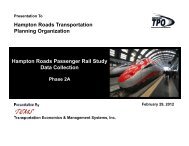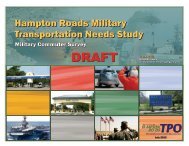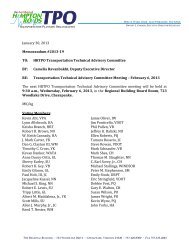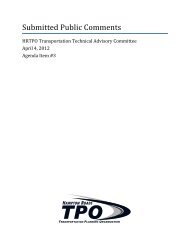Hampton Roads Regional Bridge Study
Hampton Roads Regional Bridge Study
Hampton Roads Regional Bridge Study
Create successful ePaper yourself
Turn your PDF publications into a flip-book with our unique Google optimized e-Paper software.
BRIDGE INSPECTIONS AND RATINGS 9<br />
BRIDGE INSPECTIONS AND RATINGS<br />
<strong>Bridge</strong>s must be inspected on a regular basis to ensure that they can<br />
safely remain in use. <strong>Bridge</strong>s throughout Virginia and the United States<br />
are inspected based on the National <strong>Bridge</strong> Inspection Standards (NBIS).<br />
In accordance with federal law, the NBIS sets the national standards for<br />
the proper inspection and evaluation of all highway bridges included in<br />
the National <strong>Bridge</strong> Inventory (NBI). These standards include bridge<br />
inspection procedures, frequency of inspections, the components that<br />
must be inspected, qualifications of bridge inspectors, and reporting<br />
procedures.<br />
Federal law currently requires that inspections be performed on most<br />
bridges at least once every two years. Certain bridges, based on their<br />
condition or design, are inspected more frequently. For example,<br />
bridges that are classified as structurally deficient or fracture critical (both<br />
of which are described later in this report) are inspected on an annual<br />
basis to assure they can remain in service. Underwater inspections are<br />
also performed at least once every five years on those structures where it<br />
is necessary.<br />
In Virginia, VDOT is responsible for the inspections of VDOT-maintained<br />
bridges, while cities are responsible for inspecting bridges that they<br />
maintain within their boundaries. VDOT conducts over 10,000 bridge<br />
inspections each year on state-maintained structures. To conduct these<br />
inspections, VDOT employs more than 100 people and also uses qualified<br />
consultants. VDOT spends approximately $18 million annually to<br />
conduct these inspections on state-maintained bridges throughout<br />
Virginia.<br />
Inspections on city-maintained bridges are also done in accordance with<br />
National <strong>Bridge</strong> Inspection Standards, with VDOT District Structure and<br />
<strong>Bridge</strong> Engineers being responsible to ensure that bridge inspection<br />
requirements are met by each city. Although VDOT does not provide<br />
funding specifically for bridge inspections, Urban Maintenance Program<br />
funds can be used for each city’s bridge inspection costs.<br />
BRIDGE INSPECTIONS VDOT<br />
In each inspection, bridge inspectors measure and observe various<br />
components of each bridge. Based on these measurements and<br />
observations, bridge inspectors assign multiple ratings to describe the<br />
existing condition of each bridge. These ratings are divided into general<br />
condition ratings and appraisal ratings.<br />
General condition ratings are used to assess the physical condition of the<br />
existing structure. General condition ratings are given to three<br />
components of each bridge:<br />
<br />
<br />
<br />
Deck – The overall condition rating of the bridge’s driving<br />
surface.<br />
Superstructure – The physical condition of all of the bridge’s<br />
structural members such as beams and girders.<br />
Substructure – The physical condition of all of the bridge’s piers,<br />
abutments, piles, footings, and other components of the bridge’s<br />
foundation.<br />
HAMPTON James City/Williamsburg/York ROADS REGIONAL Transportation BRIDGE STUDY <strong>Study</strong>












